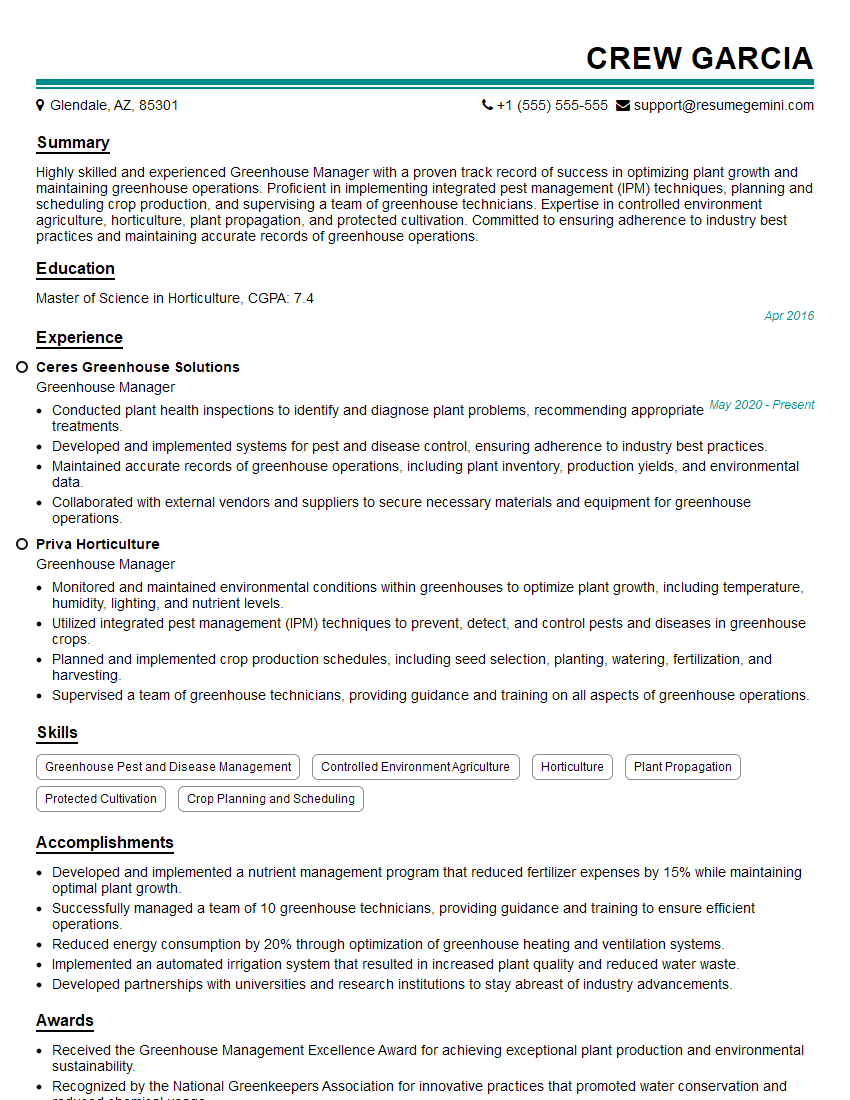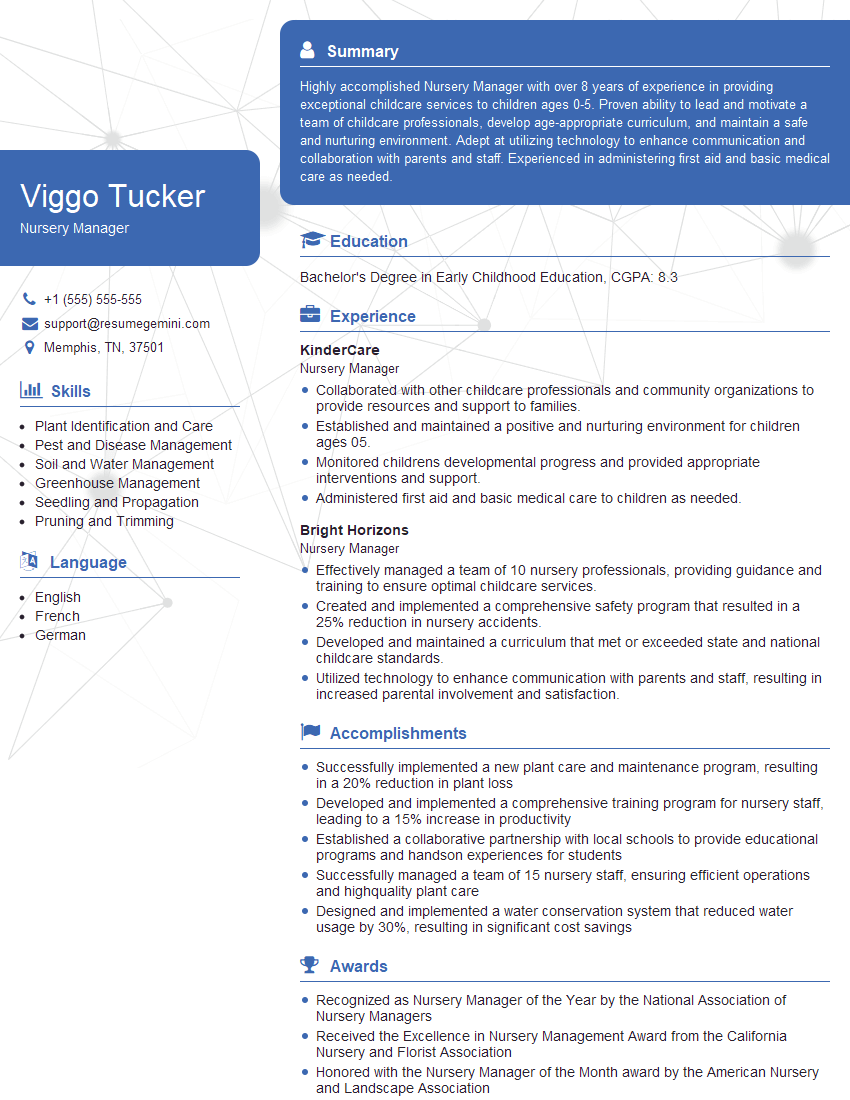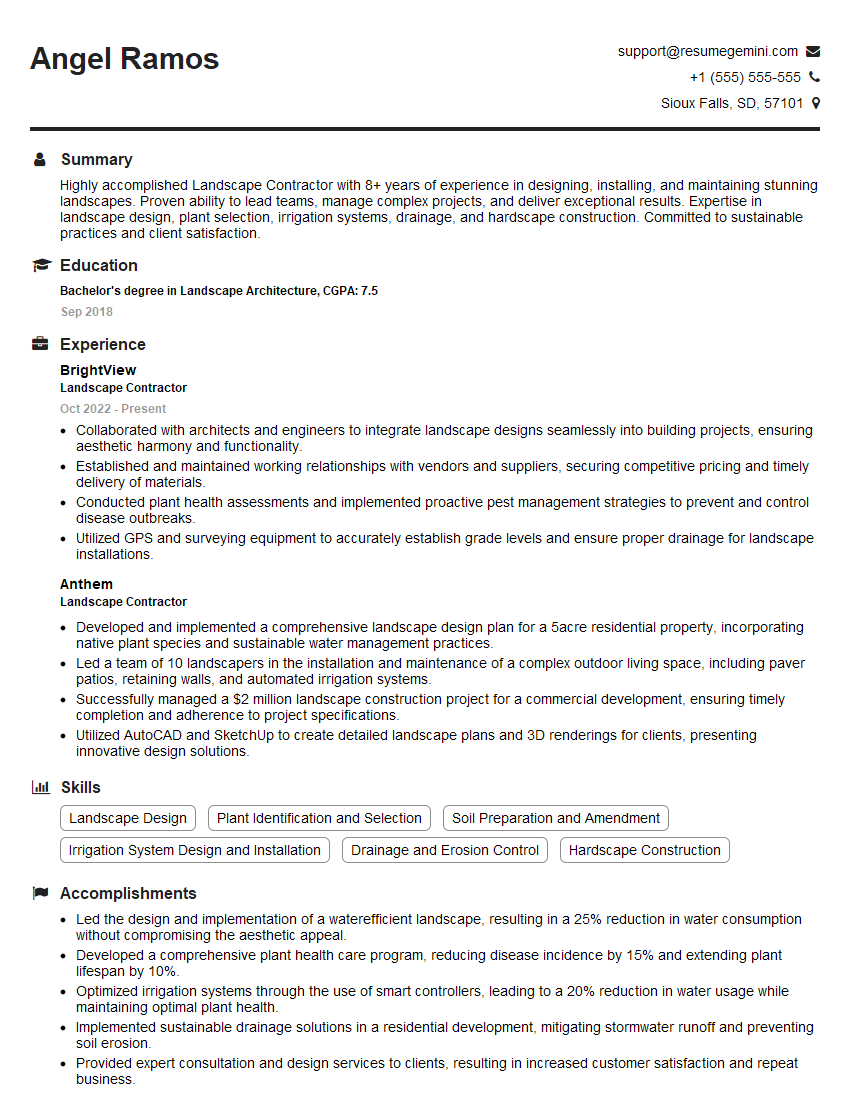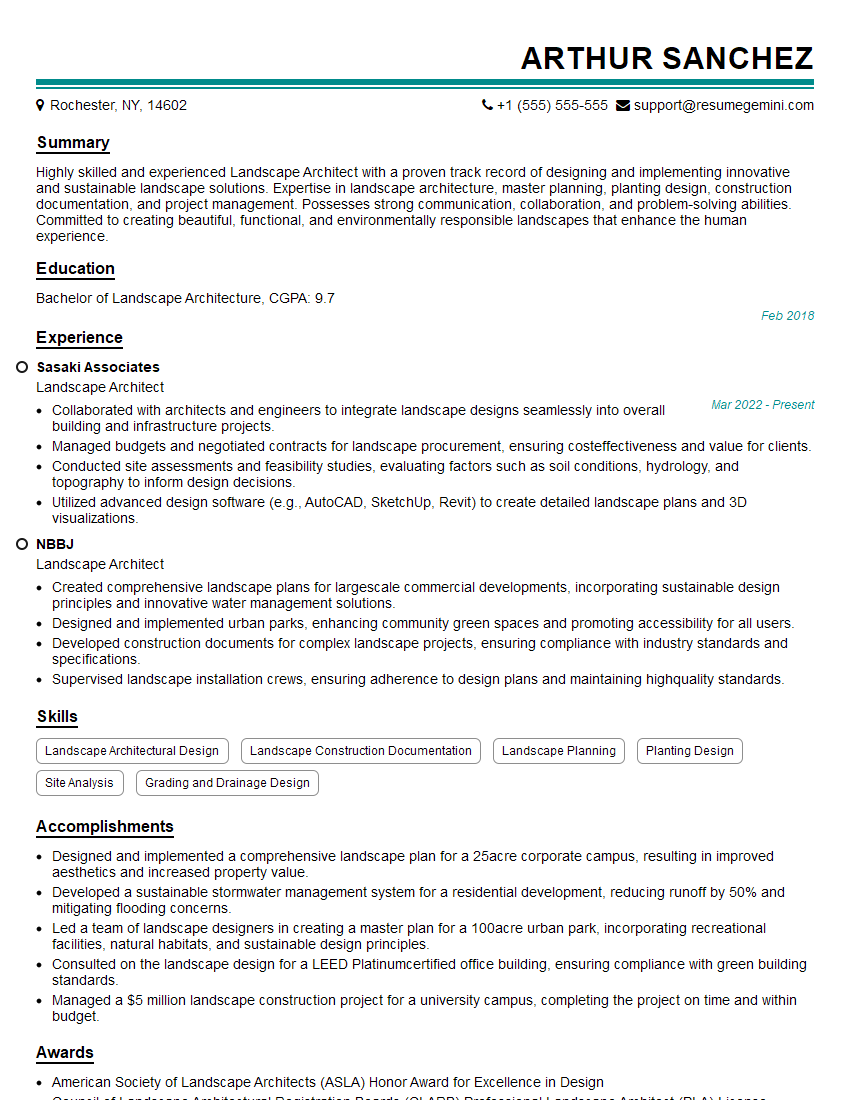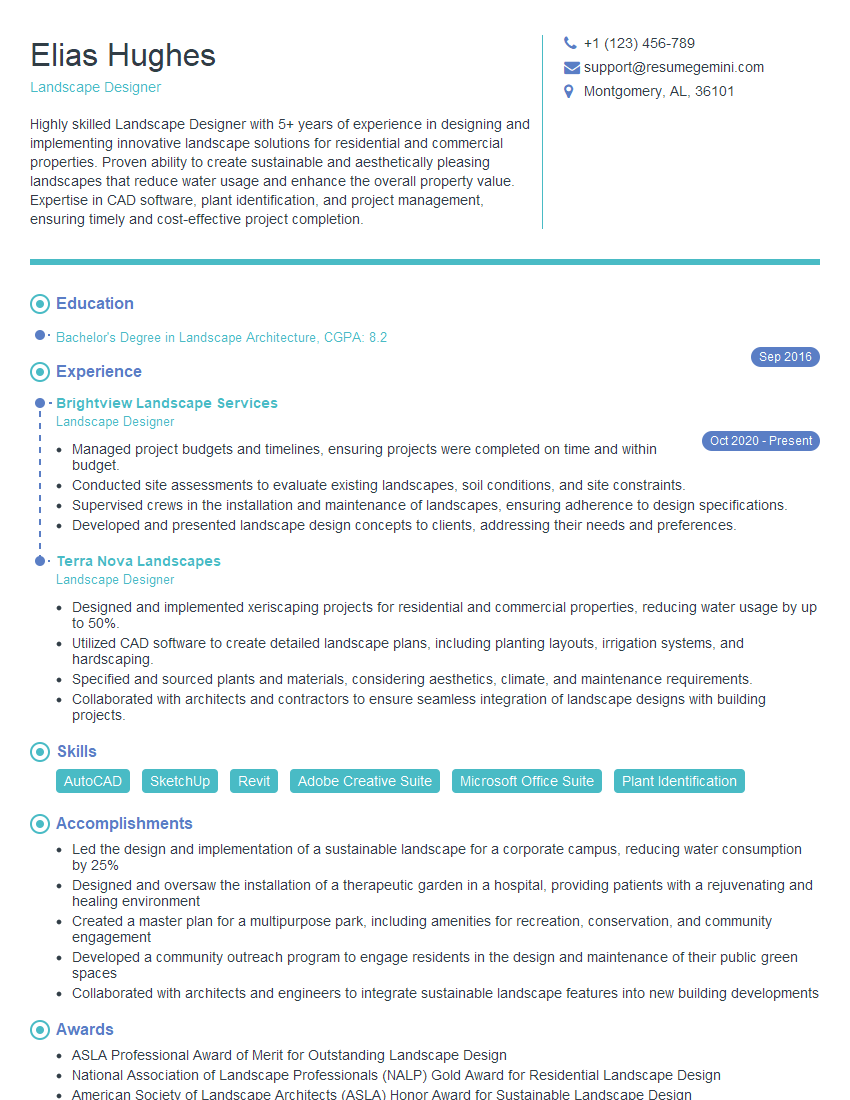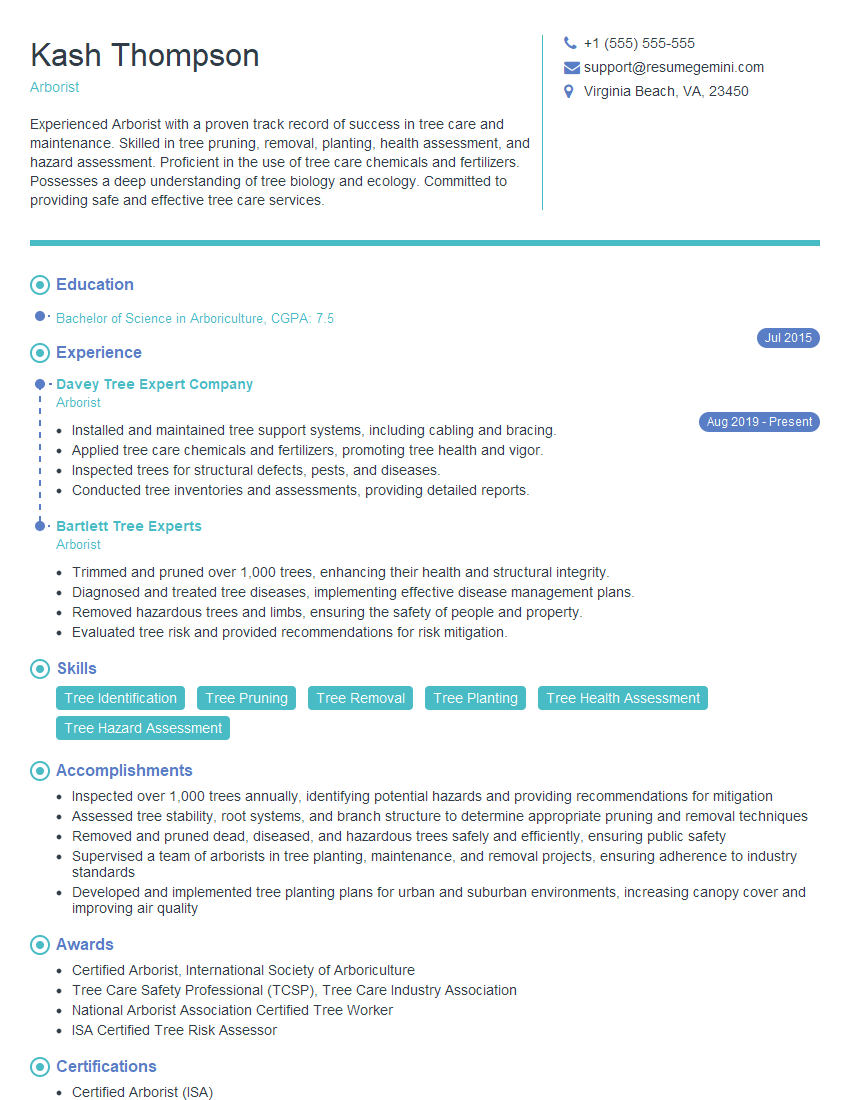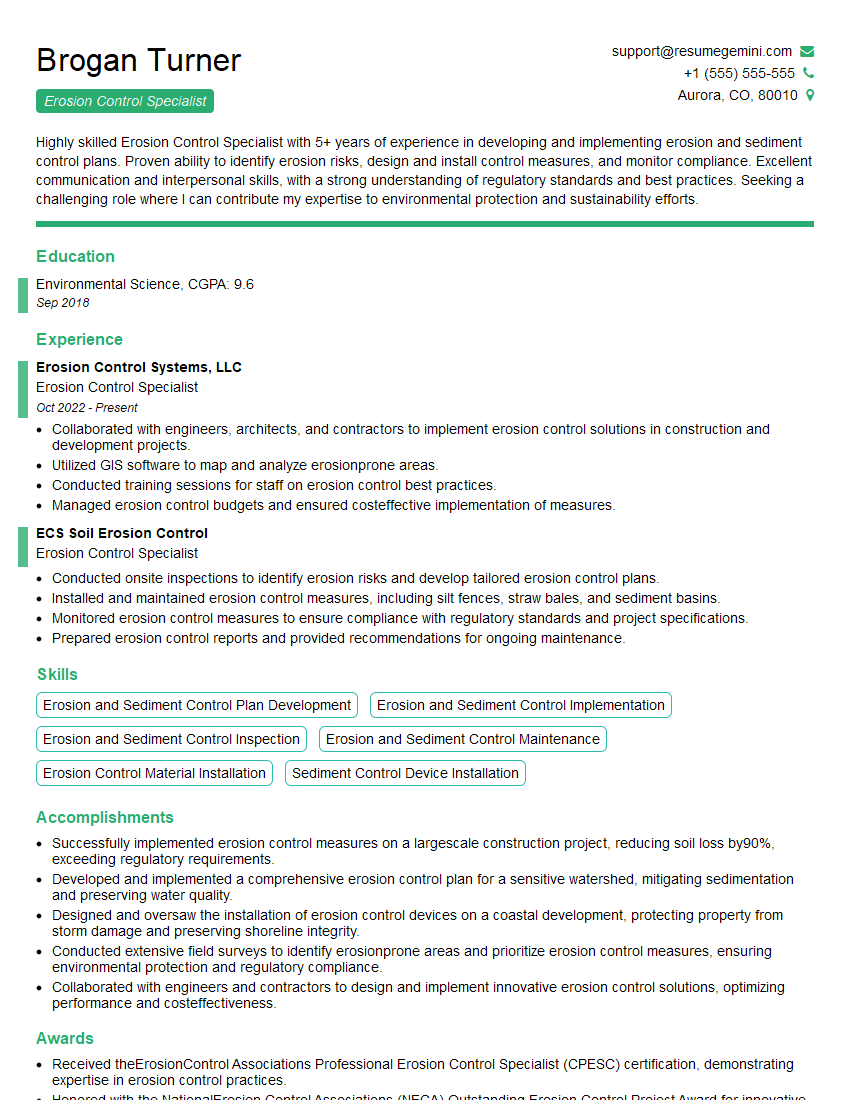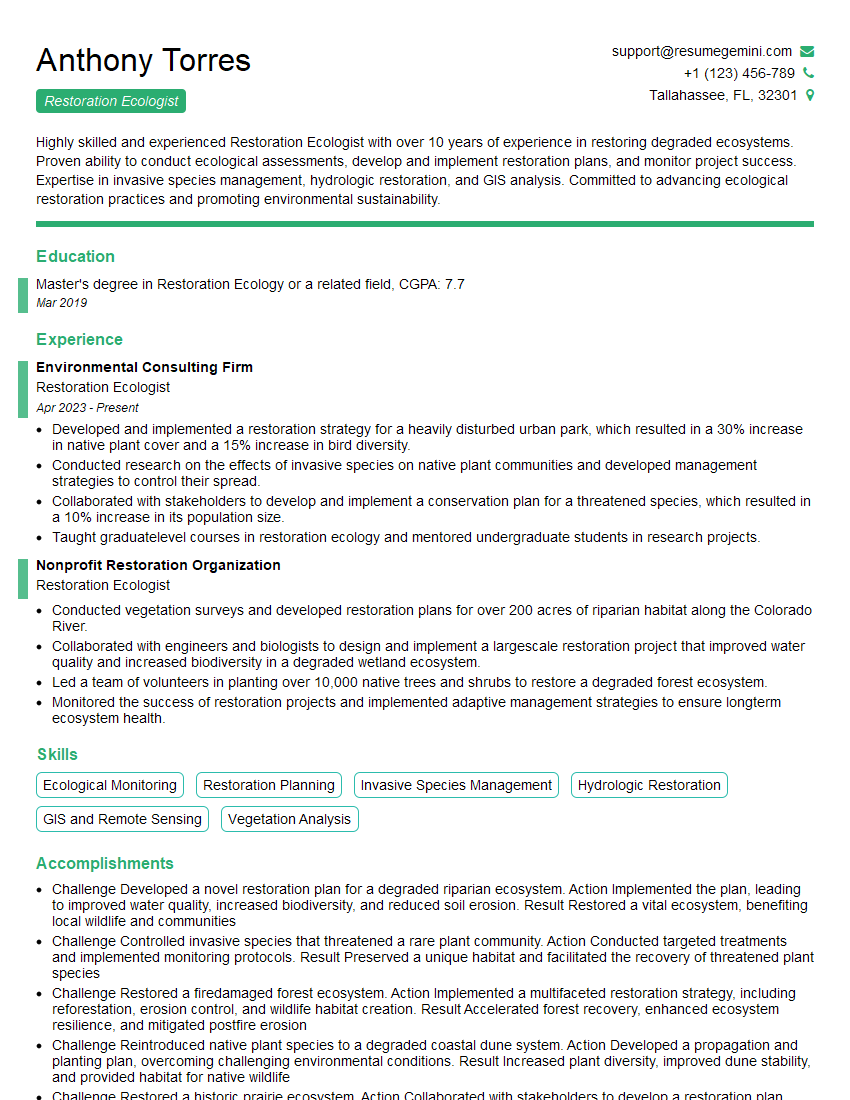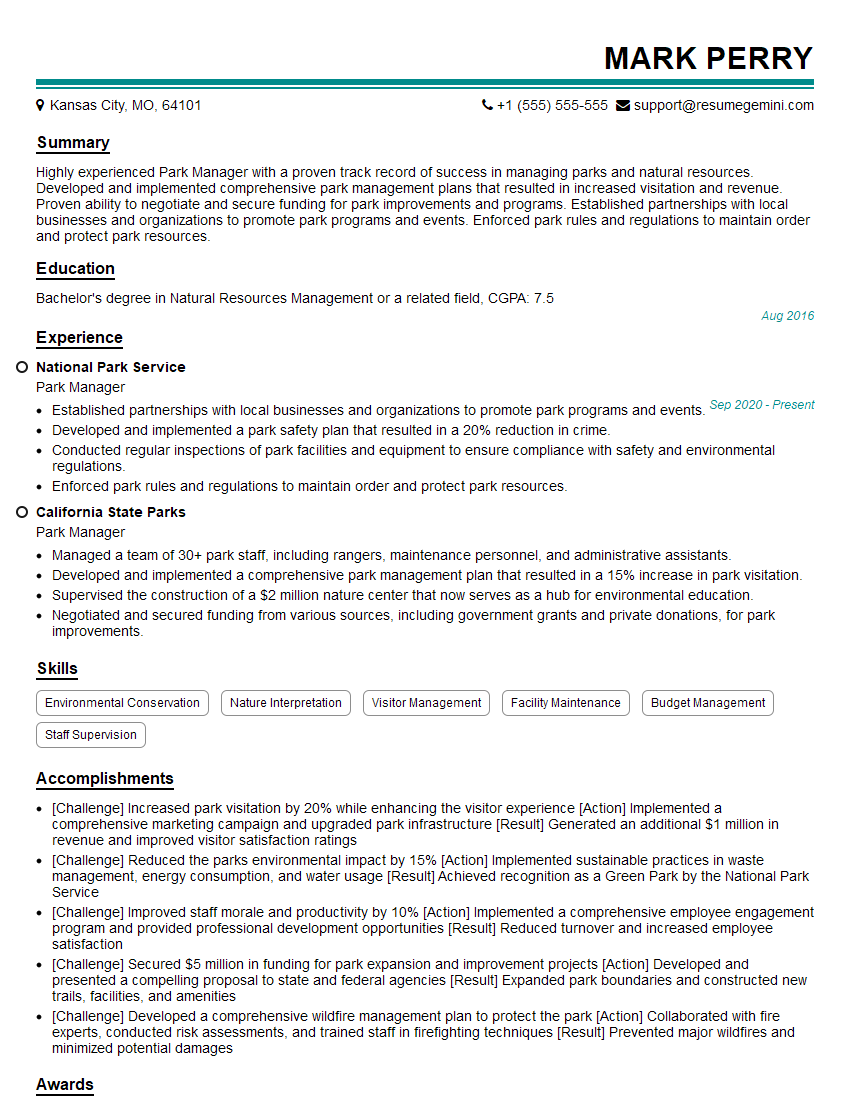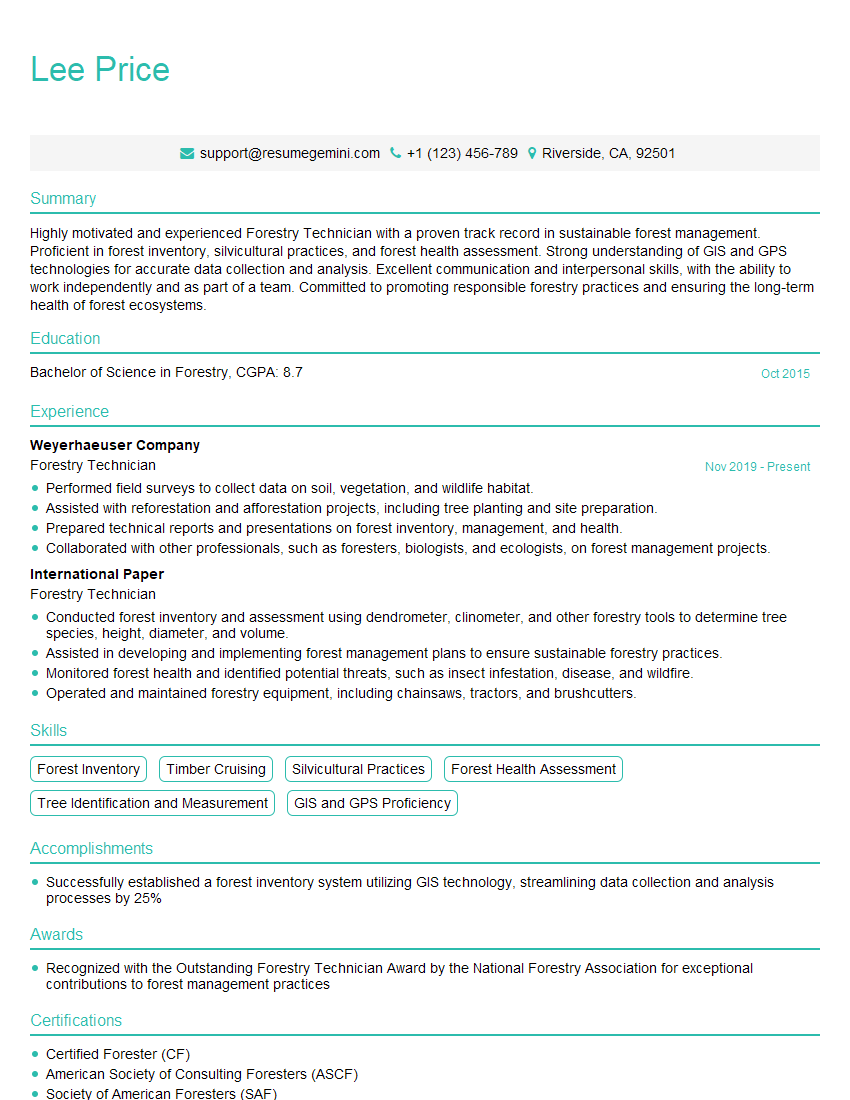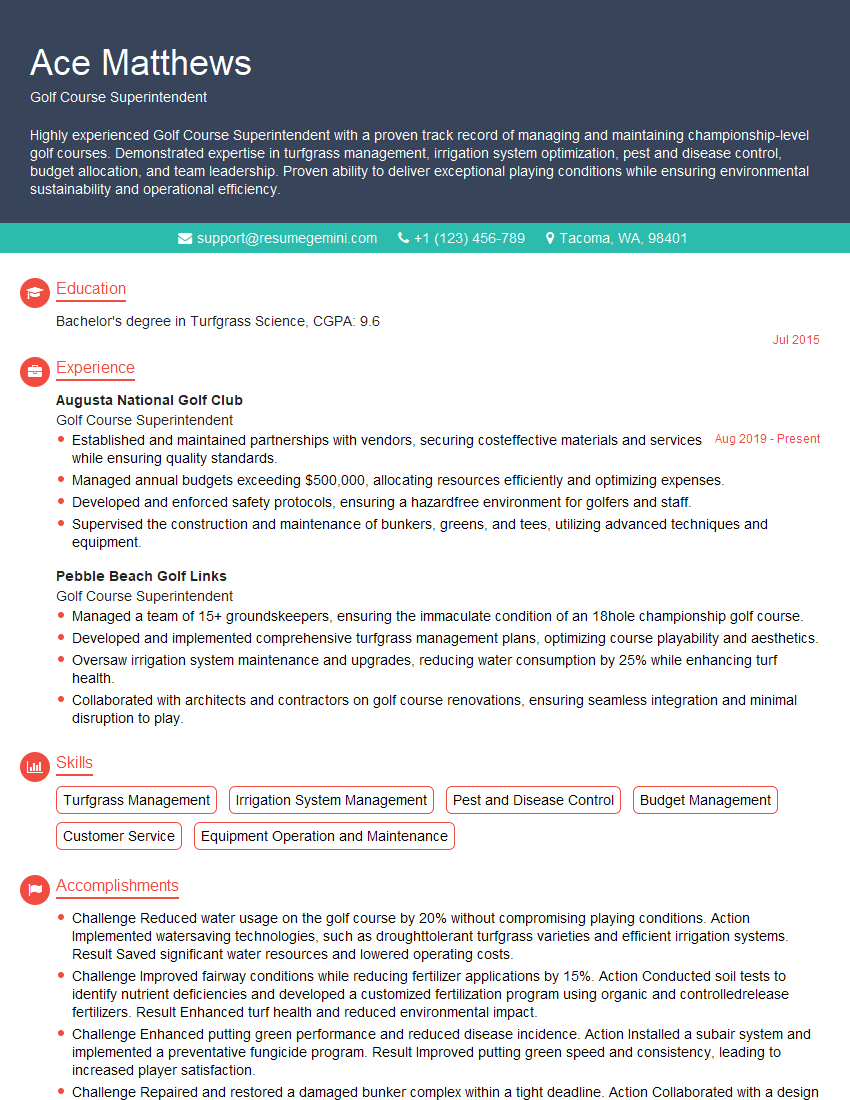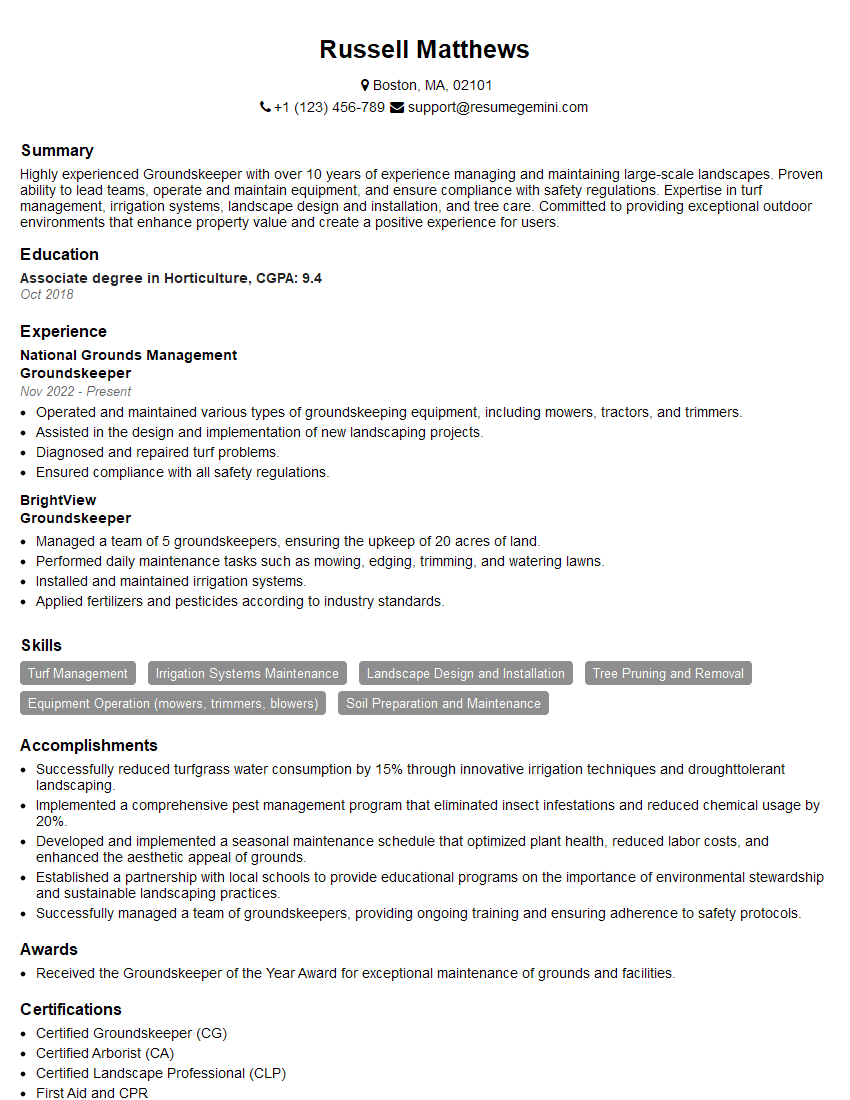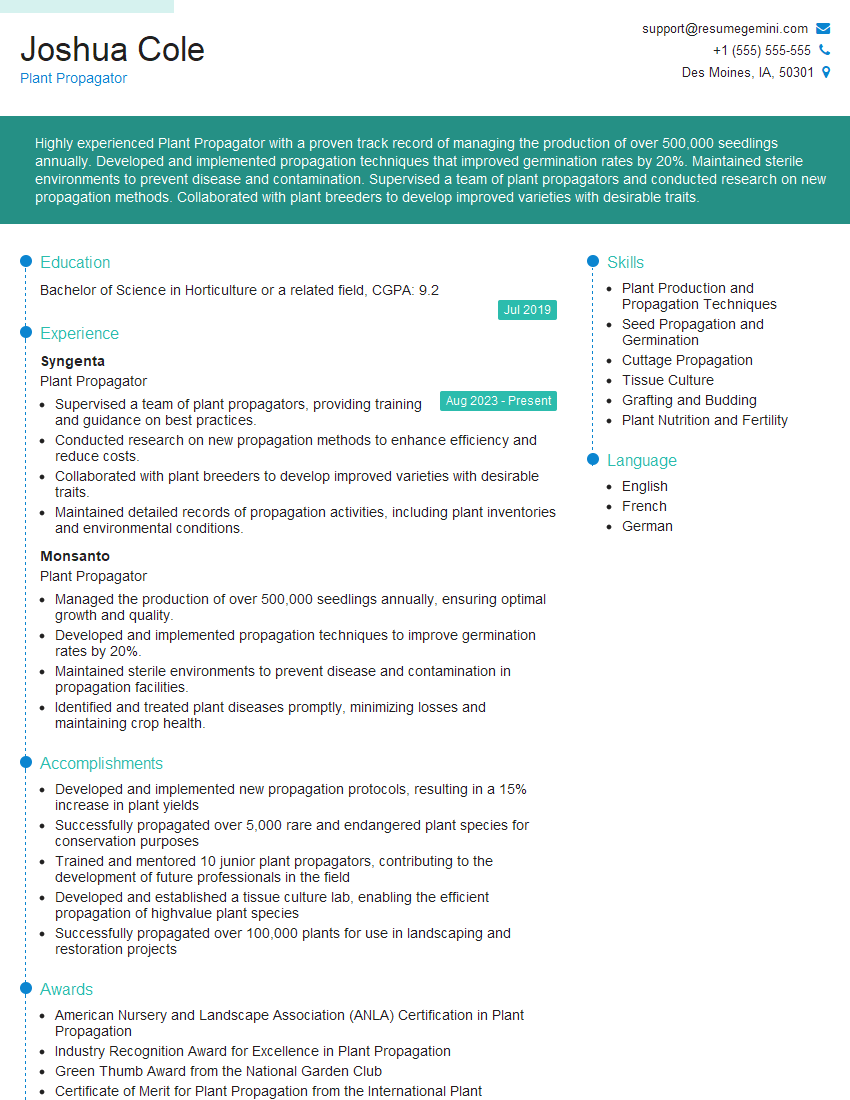The thought of an interview can be nerve-wracking, but the right preparation can make all the difference. Explore this comprehensive guide to Vegetative Establishment interview questions and gain the confidence you need to showcase your abilities and secure the role.
Questions Asked in Vegetative Establishment Interview
Q 1. Explain the process of site preparation for vegetative establishment.
Site preparation is crucial for successful vegetative establishment. It’s like preparing the soil for a house – you wouldn’t build on unstable ground! The process involves several key steps, all aimed at creating an optimal environment for plant growth.
- Clearing and Cleaning: Removing existing vegetation, debris, rocks, and any other obstructions. This might involve mowing, tilling, or even using herbicides, depending on the site and its condition. Imagine clearing a field for a new crop of sunflowers; you’d need to remove weeds and any existing plants first.
- Soil Testing: Analyzing the soil’s pH, nutrient levels, and texture. This informs decisions about soil amendments (more on this later). It’s like getting a health check for your soil before planting.
- Soil Amendment: Adding organic matter (compost, manure) and other materials to improve soil structure, drainage, and fertility. Think of this as adding vitamins to your soil to make it healthy and strong.
- Grading and Shaping: Leveling the land to ensure proper drainage and prevent waterlogging. This step is crucial, especially on slopes, to prevent erosion and promote even water distribution.
- Weed Control: Implementing pre-emergent herbicides to prevent weed growth before planting. This is important to minimize competition for resources.
The specific steps and their intensity will vary widely depending on the site’s characteristics and the chosen plant species. A heavily degraded site will require more extensive preparation than a previously cultivated field.
Q 2. Describe different methods of plant propagation.
Plant propagation, or the creation of new plants, can be achieved through various methods, each with its own advantages and disadvantages:
- Sexual Propagation (from seed): This involves using seeds to grow new plants. It’s generally inexpensive and can produce a large number of plants, but it can be slow, and offspring may not be genetically identical to the parent plant. Think of growing sunflowers from their seeds – each seed has the potential to become a new plant, but the resulting sunflowers might slightly differ in size or other characteristics.
- Asexual Propagation (vegetative propagation): This involves creating new plants from vegetative parts of the parent plant, such as stems, leaves, or roots. It’s faster and produces plants genetically identical to the parent, but it can be more labor-intensive and yield fewer plants. Examples include:
- Cuttings: Taking a stem or leaf and rooting it to form a new plant. Many houseplants are propagated this way.
- Layering: Bending a stem to the ground, covering part of it with soil, and waiting for it to root before separating it from the parent plant.
- Division: Separating a mature plant into smaller, independent plants.
- Grafting: Joining a stem or bud from one plant (the scion) onto the rootstock of another plant.
Choosing the right propagation method depends on the species, the desired number of plants, and available resources.
Q 3. What are the key factors to consider when selecting plant species for a specific site?
Selecting appropriate plant species is critical for project success. It’s like choosing the right tools for a job – the wrong tool won’t get the work done efficiently, or at all! Key factors to consider include:
- Climate: Temperature, rainfall, sunlight, and frost tolerance. A desert plant won’t thrive in a rainforest.
- Soil Conditions: pH, drainage, texture, nutrient content. Some plants prefer sandy soil, while others need clay.
- Site Characteristics: Elevation, slope, aspect (direction the site faces). A plant needing full sun won’t thrive in a shady area.
- Desired Function: Erosion control, landscaping, wildlife habitat, etc. Different plants are suited for different purposes.
- Maintenance Requirements: Some plants require more watering, fertilization, and pruning than others. Consider your budget and time constraints.
Careful consideration of these factors ensures that chosen plants are well-suited to the site and will thrive, minimizing potential failures and maximizing the project’s longevity.
Q 4. How do you determine the appropriate planting density for a given project?
Planting density, or the number of plants per unit area, significantly impacts plant growth and project success. Too many plants lead to competition for resources, while too few might leave gaps and allow weeds to take over. Determining the right density involves considering several factors:
- Plant Species: Different species have different growth habits and space requirements. A sprawling plant needs more space than a compact one.
- Site Conditions: Fertile, well-watered sites can support higher densities than poor sites.
- Project Goals: A fast-growing cover crop will have a different density than a landscape planting aiming for a mature look.
- Available Resources: The amount of water and nutrients available will influence the maximum sustainable density.
Often, recommendations are provided by nurseries or through research on the specific species. However, adjustments are often needed based on specific site conditions. It’s common to start with a slightly higher density and then thin plants out if necessary after establishment.
Q 5. Explain the importance of soil testing in vegetative establishment.
Soil testing is fundamental to successful vegetative establishment. It provides a snapshot of the soil’s health, revealing crucial information for informed decisions. It’s like getting a blood test for your soil! Key aspects include:
- pH: Determines soil acidity or alkalinity, influencing nutrient availability. Different plants have different pH preferences.
- Nutrient Levels: Reveals deficiencies (e.g., nitrogen, phosphorus, potassium) that need to be addressed through fertilization.
- Texture: Indicates the proportion of sand, silt, and clay, impacting drainage, aeration, and water retention.
- Organic Matter Content: Shows the amount of decomposing organic material, crucial for soil structure and fertility.
The results of a soil test guide the selection of appropriate plant species and inform the need for soil amendments to optimize growth conditions. Ignoring this critical step can lead to poor plant performance or even failure.
Q 6. Describe different irrigation techniques and their suitability for various plant types.
Irrigation is essential for establishing vegetation, especially during the critical establishment phase. The method chosen depends heavily on the plant type, site conditions, and available resources.
- Drip Irrigation: Delivers water directly to the plant roots, minimizing water waste and evaporation. Ideal for sensitive plants or areas with limited water resources. Think of it as giving each plant a personal drink.
- Sprinkler Irrigation: Sprays water over a larger area, suitable for larger projects or less sensitive plants. It’s like watering the entire garden with a hose.
- Flood Irrigation: Floods the area with water, efficient for large, flat areas but can lead to waterlogging if not managed properly. It’s a more hands-off approach.
- Overhead Irrigation: Water is sprayed from above, can be efficient but can lead to disease if not managed properly. It’s less targeted than drip irrigation.
The selection process involves balancing water efficiency, cost, and the specific needs of the plant species being established. For example, drought-tolerant plants may require less frequent watering and may be better suited to sprinkler irrigation, while delicate seedlings might benefit from the precision of drip irrigation.
Q 7. How do you manage weed control in newly established vegetation?
Weed control is vital in newly established vegetation because weeds compete for water, nutrients, and sunlight, hindering plant growth. A multi-pronged approach is usually most effective:
- Pre-emergent Herbicides: Applied before weeds germinate, preventing their emergence. This is a proactive measure, similar to preventative medicine.
- Post-emergent Herbicides: Applied after weeds have emerged, targeting specific weed species. This is a reactive measure, addressing a current problem.
- Mechanical Control: Includes hand-weeding, hoeing, or cultivation. This is labor-intensive but environmentally friendly. It’s like physically removing the weeds.
- Mulching: Applying a layer of organic material (e.g., straw, wood chips) to suppress weed growth and conserve moisture. This acts as a physical barrier.
- Cultural Practices: Optimizing planting density, fertilization, and irrigation to promote vigorous plant growth, outcompeting weeds. This creates a strong and healthy environment that is less suitable for weeds.
The best approach involves integrating several methods to maximize effectiveness while minimizing environmental impact. For example, using pre-emergent herbicides followed by mulching and occasional hand-weeding can be very effective in controlling weeds without relying heavily on chemicals.
Q 8. What are the common challenges faced during vegetative establishment and how do you overcome them?
Vegetative establishment, while rewarding, presents numerous challenges. These often revolve around ensuring young plants survive and thrive in their new environment. Common issues include inadequate soil preparation resulting in poor drainage or compaction, insufficient moisture leading to wilting and stress, competition from weeds that out-compete young seedlings for resources, and damage from pests and diseases.
Overcoming these challenges requires a proactive and multi-faceted approach. Thorough site preparation is crucial, involving soil testing to understand nutrient levels and pH, appropriate grading to promote drainage, and weed control measures before planting. Efficient irrigation systems, matched to the specific needs of the species being established, are essential. Careful selection of plant materials, choosing species best suited to the site conditions and using high-quality planting stock, minimizes initial stress. Finally, regular monitoring and timely intervention with appropriate pest and disease control measures are vital for successful establishment.
For example, on a recent project involving roadside revegetation, we tackled poor soil compaction by employing deep ripping before planting, improving root penetration. We also used a bio-degradable mulch to suppress weeds and retain moisture.
Q 9. Explain the principles of erosion control in vegetative establishment.
Erosion control in vegetative establishment is paramount, preventing the loss of valuable topsoil and ensuring the long-term success of the planted vegetation. The principles focus on slowing water flow, increasing infiltration, and stabilizing the soil surface. This is achieved through a combination of techniques, often employed synergistically.
These techniques include the use of cover crops, which quickly establish a root system binding the soil and preventing erosion. Mulching, whether organic or synthetic, protects the soil surface from raindrop impact and reduces runoff. Contouring and terracing redirect water flow, reducing its erosive power. Finally, using vegetation with strong root systems, particularly those that form dense mats or extensive networks, provides mechanical stability to the soil. The selection of appropriate species is therefore crucial, considering their growth habits and tolerance to site conditions.
Think of it like building a strong foundation for a house: the soil needs to be stable to support the new vegetation. Ignoring erosion control is like building a house on shifting sand.
Q 10. Describe your experience with different mulching techniques.
My experience encompasses a range of mulching techniques, each suited to different situations. Organic mulches, such as wood chips, straw, and compost, offer several advantages, including soil improvement through nutrient release and enhanced water retention. However, they can harbor weed seeds and decompose over time, requiring replenishment. In contrast, synthetic mulches, like plastic sheeting or landscape fabric, provide a more durable, weed-suppressing barrier, but they can impede water penetration and prevent soil aeration if not installed carefully.
I’ve used wood chip mulch extensively in forest restoration projects, appreciating its ability to mimic the natural forest floor and improve soil conditions. In arid environments, I’ve favored straw mulch for its water retention properties. On high-traffic areas requiring longer-lasting weed suppression, synthetic mulches were more practical. The choice depends on factors such as site conditions, budget, and environmental impact considerations.
Q 11. How do you monitor the health and growth of newly established vegetation?
Monitoring the health and growth of newly established vegetation is an ongoing process, involving regular visual inspections and, in some cases, more quantitative measurements. Visual assessments focus on key indicators such as plant vigor (appearance of health and growth), incidence of disease or pest damage, and overall survival rates. Quantitative measurements may include height and diameter growth, canopy cover, and biomass estimations.
We typically establish a monitoring schedule, with initial checks more frequent during the critical establishment phase and then less frequent as the plants mature. Photographs are often taken at each monitoring point to document changes over time. Data collected are analyzed to assess the effectiveness of establishment techniques and to identify any issues requiring remedial action. This allows for timely interventions, such as supplemental irrigation or pest control, preventing more extensive damage.
For example, we use GIS mapping to track survival rates and growth across large-scale revegetation projects, enabling targeted interventions in areas experiencing difficulties.
Q 12. What are the signs of plant stress and how do you address them?
Signs of plant stress can manifest in various ways, depending on the cause. Wilting, leaf discoloration (yellowing, browning, or purpling), stunted growth, and leaf drop are common indicators. Specific symptoms can often point to the underlying cause. For example, wilting might suggest insufficient water or root damage, while yellowing leaves could indicate nutrient deficiencies. Pest and disease damage present specific symptoms, such as leaf lesions, discoloration patterns or the presence of insects.
Addressing plant stress requires identifying the cause and implementing appropriate corrective measures. This might involve adjusting irrigation practices, applying fertilizers, controlling pests and diseases with appropriate methods (chemical or biological), or adjusting planting techniques in subsequent plantings.
In one case, we observed yellowing leaves in a newly planted area. Soil testing revealed a severe potassium deficiency, prompting targeted fertilizer application, which quickly resolved the issue.
Q 13. Explain the importance of proper fertilization in vegetative establishment.
Proper fertilization plays a vital role in vegetative establishment, providing the essential nutrients required for healthy growth and development. Nutrients like nitrogen, phosphorus, and potassium are crucial for leaf growth, root development, and overall plant vigor. The correct balance of nutrients, tailored to the specific needs of the plants and soil conditions, is crucial. Over-fertilization can be just as detrimental as under-fertilization, potentially causing salt burn or nutrient imbalances.
Soil testing is critical to determining nutrient deficiencies and guiding fertilizer application rates. The type of fertilizer used (organic vs. inorganic) depends on the overall management objectives and environmental considerations. Slow-release fertilizers offer a sustained nutrient supply, reducing the need for frequent applications. Careful timing of fertilizer applications also contributes to efficient nutrient uptake and minimized nutrient loss.
I always emphasize the importance of soil testing before recommending any fertilization strategy. It’s like giving a person the right diet – not too much, not too little, just the right balance for optimal health.
Q 14. Describe your experience with different pest and disease management strategies.
My experience encompasses a variety of pest and disease management strategies, prioritizing integrated pest management (IPM) principles. IPM emphasizes prevention, monitoring, and targeted interventions using the least harmful methods possible. This approach combines cultural practices (e.g., proper plant spacing, irrigation management), biological controls (e.g., introducing beneficial insects), and chemical controls (only when absolutely necessary and with appropriate safety measures).
Cultural practices often form the first line of defense. Proper site preparation, selecting disease-resistant cultivars, and ensuring adequate plant spacing can significantly reduce pest and disease problems. Biological controls, such as introducing beneficial nematodes or deploying microbial agents, offer effective, environmentally friendly alternatives to chemical pesticides. Chemical controls should only be used as a last resort, selecting the least toxic product and following label instructions carefully. Regular monitoring is essential for early detection of pests and diseases, allowing for timely intervention and minimizing the need for extensive control measures.
For example, in a recent project battling a fungal disease, we first employed cultural controls (improved drainage), then introduced a biocontrol agent. Only after assessing their effectiveness did we resort to a targeted chemical treatment.
Q 15. How do you ensure the long-term success of a vegetative establishment project?
Ensuring the long-term success of a vegetative establishment project hinges on a multifaceted approach that begins long before the first plant is put in the ground and continues long after the project is considered ‘complete’. It’s about creating a robust and resilient ecosystem that can withstand environmental stresses and thrive.
- Site Assessment and Planning: A thorough site analysis is paramount. This includes evaluating soil conditions, water availability, sunlight exposure, and existing vegetation. Understanding these factors allows for informed species selection and appropriate site preparation techniques.
- Species Selection: Choosing the right plant species is critical. Consider factors such as drought tolerance, pest resistance, and growth rate. Diversity is key – a monoculture is far more vulnerable to disease or environmental changes than a diverse planting scheme.
- Proper Planting Techniques: The success of any planting effort depends heavily on proper planting techniques. This includes correct spacing, depth, and watering. We often use techniques like containerized seedlings or bare-root planting, choosing the method best suited to the species and site conditions.
- Post-Planting Care: Ongoing maintenance is essential for long-term success. This includes regular watering, weeding, fertilization, and pest and disease management. A carefully developed maintenance plan is crucial, which often involves regular monitoring and adaptive management.
- Monitoring and Adaptive Management: Regular monitoring allows us to track the progress of the vegetation and identify any potential problems early on. This might involve visual inspections, soil testing, or other monitoring techniques. Adaptive management means adjusting our strategies based on what we observe – for example, changing watering schedules based on rainfall patterns.
For example, in a recent coastal restoration project, we carefully selected salt-tolerant native grasses and monitored soil salinity levels to ensure optimal growth. By implementing a robust post-planting care plan, we achieved a 95% survival rate and established a thriving coastal habitat.
Career Expert Tips:
- Ace those interviews! Prepare effectively by reviewing the Top 50 Most Common Interview Questions on ResumeGemini.
- Navigate your job search with confidence! Explore a wide range of Career Tips on ResumeGemini. Learn about common challenges and recommendations to overcome them.
- Craft the perfect resume! Master the Art of Resume Writing with ResumeGemini’s guide. Showcase your unique qualifications and achievements effectively.
- Don’t miss out on holiday savings! Build your dream resume with ResumeGemini’s ATS optimized templates.
Q 16. What software or tools do you use for project management in vegetative establishment?
Project management in vegetative establishment requires robust tools to handle the complex interplay of planning, resource allocation, and progress tracking. I utilize a combination of software and tools tailored to different aspects of the project.
- Project Management Software: I frequently use software like Asana or Monday.com to manage tasks, deadlines, and team communication. These platforms allow for efficient task assignment, progress monitoring, and collaborative documentation.
- GIS Software: Geographic Information Systems (GIS) software, such as ArcGIS, is indispensable for mapping, site analysis, and visualizing project progress. We use GIS to map areas for planting, track plant health, and monitor changes over time.
- Spreadsheets: Spreadsheets (Excel or Google Sheets) are essential for budgeting, tracking material usage, and compiling data from site monitoring. They provide a simple yet effective way to organize and analyze quantitative data.
- Specialized Vegetation Management Software: Depending on the project’s scale and complexity, we may also use specialized software for modeling vegetation growth, predicting species distribution, or simulating environmental impacts.
For instance, in a large-scale reforestation project, we used GIS to optimize planting locations based on slope, soil type, and proximity to water sources. The project management software kept our team organized and ensured efficient task completion across multiple field crews.
Q 17. Describe your experience with different types of planting equipment.
My experience encompasses a broad range of planting equipment, each suited to specific tasks and site conditions. The choice of equipment depends on factors such as project scale, terrain, plant species, and budget.
- Manual Planting Tools: For smaller projects or areas with difficult access, manual tools like shovels, trowels, and hand-held augers remain essential. They allow for precise planting and minimize soil disturbance in sensitive areas.
- Mechanical Planters: For larger-scale projects, mechanical planters significantly increase efficiency. These can range from simple, tractor-mounted planters to more sophisticated machines capable of automated planting, spacing, and fertilization. We’ve used these successfully in agricultural settings and large-scale restoration projects.
- Aerial Seeding: In challenging terrain or vast areas, aerial seeding using helicopters or planes can be a cost-effective method for broadcasting seeds. This is particularly useful for establishing vegetation in remote or inaccessible locations.
- Hydro-Seeding Equipment: Hydro-seeding uses a slurry of seeds, mulch, and fertilizer that is sprayed onto the ground. This is effective for erosion control and establishing vegetation on slopes or in areas with poor soil conditions. We often use this technique on steep embankments or areas prone to erosion.
For example, in a recent highway restoration project, we utilized a combination of mechanical planters and hydro-seeding to establish vegetation on both flat and sloped areas along the highway embankment, resulting in effective erosion control and aesthetically pleasing roadside landscaping.
Q 18. How do you handle unexpected challenges or setbacks during a project?
Unexpected challenges are inevitable in vegetative establishment projects. My approach to handling setbacks involves proactive planning, meticulous monitoring, and a flexible, adaptive mindset.
- Risk Assessment and Contingency Planning: Before commencing any project, we conduct a thorough risk assessment to identify potential problems and develop contingency plans. This might involve anticipating issues like drought, pest infestations, or equipment malfunctions.
- Regular Monitoring and Early Detection: Regular monitoring allows us to detect problems early on, enabling timely intervention. For instance, detecting a pest infestation early can significantly limit its impact.
- Problem-Solving and Adaptation: When problems arise, we employ a systematic approach to identify the cause, assess the extent of the damage, and implement appropriate solutions. This may involve adjusting planting techniques, using different species, or implementing pest control measures.
- Communication and Collaboration: Open communication with stakeholders, including clients, contractors, and regulatory agencies, is crucial for effective problem-solving. Collaborating with experts can bring diverse perspectives and specialized knowledge.
For example, during a prairie restoration project, an unexpected drought threatened the survival of the seedlings. We responded by implementing supplemental watering, selecting more drought-tolerant species, and adjusting the maintenance plan to ensure the project’s success.
Q 19. What is your experience with native plant selection and its benefits?
Native plant selection is a cornerstone of successful and ecologically sound vegetative establishment projects. Native plants are adapted to the local climate, soil conditions, and pest pressures, making them more resilient and requiring less maintenance than non-native species.
- Ecological Benefits: Native plants support local wildlife by providing food and habitat. They contribute to biodiversity and enhance ecosystem health. They also help restore degraded ecosystems to their natural state.
- Reduced Maintenance: Because native plants are adapted to the local environment, they generally require less watering, fertilization, and pest control than non-native species. This translates to lower costs and a reduced environmental footprint.
- Aesthetic Value: Native plants can provide beautiful and diverse landscaping options, enhancing the visual appeal of a project while still contributing to ecological restoration.
- Regulatory Compliance: Many jurisdictions encourage or require the use of native plants in restoration and landscaping projects. Selecting native plants can ensure compliance with local regulations and avoid potential penalties.
In a recent wetland restoration project, we used native wetland plants such as cattails and sedges. Their deep root systems stabilized the soil, improved water quality, and provided habitat for various wetland species. The result was a thriving wetland ecosystem with minimal maintenance requirements.
Q 20. Explain the concept of biodiversity in vegetative establishment.
Biodiversity in vegetative establishment refers to the variety of plant species used in a project. A diverse planting design is crucial for creating a resilient and functional ecosystem. It mirrors natural ecosystems, which are characterized by a high degree of species richness and diversity.
- Increased Resilience: A diverse planting scheme is less vulnerable to pests, diseases, and environmental stresses than a monoculture. If one species is affected, others can compensate, maintaining the overall health of the vegetation.
- Enhanced Ecosystem Services: A diverse plant community provides a wider range of ecosystem services, such as improved soil health, increased water infiltration, and enhanced carbon sequestration.
- Support for Wildlife: A variety of plant species provides habitat and food sources for a greater diversity of wildlife, enhancing biodiversity beyond just the plant community itself.
- Aesthetic Appeal: A diverse planting design can create a more visually appealing and engaging landscape, offering a variety of colors, textures, and forms throughout the year.
For example, in a grassland restoration project, we incorporated a mix of native grasses, forbs, and wildflowers, creating a robust and diverse plant community that supported a wide array of insect, bird, and mammal species.
Q 21. How do you ensure compliance with environmental regulations during a project?
Compliance with environmental regulations is paramount in all vegetative establishment projects. My approach to ensuring compliance involves proactive planning, thorough documentation, and collaboration with regulatory agencies.
- Pre-Project Review: We begin by reviewing all relevant environmental regulations and permits required for the project. This ensures we understand the specific requirements and potential constraints.
- Species Selection and Sourcing: We carefully select plant species appropriate for the site and ensure they are sourced from reputable suppliers who can provide documentation of their origin and propagation methods. This helps prevent the introduction of invasive species.
- Erosion and Sediment Control: We implement appropriate erosion and sediment control measures throughout the project to minimize environmental impacts. This might include using silt fences, straw bales, or other erosion control techniques.
- Waste Management: We manage all project waste responsibly, ensuring that construction debris and other materials are disposed of properly to minimize environmental impact. This is often required by permits and contributes to sustainability goals.
- Post-Project Monitoring: We conduct post-project monitoring to ensure compliance with regulations and evaluate project success. We may need to submit reports to regulatory agencies demonstrating our adherence to permit conditions.
For example, in a riparian restoration project, we worked closely with the local environmental agency to obtain all necessary permits and implement measures to protect water quality during construction. We submitted regular progress reports demonstrating our compliance with the permit conditions.
Q 22. Describe your experience with budget management in vegetative establishment projects.
Budget management in vegetative establishment is crucial for project success. It’s not just about tracking expenses; it’s about strategic allocation of resources to maximize efficiency and achieve project goals. My experience involves meticulously developing comprehensive budgets, encompassing all aspects from plant material costs and labor to equipment rental and unforeseen contingencies. I utilize specialized software to track expenses in real-time, comparing actual spending against the projected budget. This allows for proactive adjustments, preventing cost overruns. For example, on a recent riparian restoration project, I identified a potential cost increase in native plant sourcing due to unexpected supplier delays. By swiftly negotiating with alternative suppliers and adjusting the planting schedule, I saved the project approximately 15% of the initial plant material budget.
I also employ value engineering techniques to identify areas where cost savings can be achieved without compromising project quality. This might involve exploring alternative planting methods, negotiating bulk discounts for materials, or optimizing labor scheduling. Regular reporting to stakeholders keeps everyone informed about financial progress and allows for timely interventions if needed. Transparency and accurate forecasting are paramount in ensuring a successful project financially.
Q 23. How do you manage a team of workers in a vegetative establishment project?
Managing a team in vegetative establishment demands strong leadership, communication, and delegation skills. I foster a collaborative environment where each team member feels valued and empowered. I begin by clearly defining roles and responsibilities, ensuring everyone understands their contribution to the overall project goal. Regular team meetings, both formal and informal, provide opportunities for updates, problem-solving, and feedback. I utilize a hands-on approach, working alongside the team and offering guidance and support as needed. This builds trust and rapport, leading to increased motivation and productivity.
Effective communication is key; I utilize various methods including daily briefings, progress reports, and one-on-one check-ins to ensure everyone is aligned. I address conflicts promptly and fairly, aiming for constructive solutions. Furthermore, I actively promote safety awareness and training, ensuring the team adheres to all safety protocols. For instance, during a steep hillside planting project, I implemented a detailed safety plan which included using specialized equipment and regular safety briefings, resulting in zero workplace accidents.
Q 24. What are your strengths and weaknesses regarding vegetative establishment?
My strengths in vegetative establishment lie in my strong technical expertise, my meticulous attention to detail, and my ability to adapt to challenging conditions. I possess in-depth knowledge of various planting techniques, soil science, and plant physiology, allowing me to make informed decisions. My attention to detail ensures that projects are executed precisely, leading to high success rates. My adaptability allows me to overcome unexpected obstacles, such as extreme weather conditions or site-specific limitations. For example, during a project impacted by a severe drought, I successfully implemented drought-tolerant planting strategies that minimized plant mortality.
While I am proficient in many areas, I constantly strive to improve my skills in project scheduling software. Though I can manage schedules effectively using traditional methods, I recognize that specialized software could enhance efficiency further. I am actively pursuing training in this area to enhance my capabilities.
Q 25. Describe a challenging vegetative establishment project and how you overcame it.
One particularly challenging project involved establishing a wetland area on a site with highly compacted soil and limited water resources. The initial soil conditions hindered root development, and the water scarcity posed a significant threat to plant survival. To overcome these challenges, I implemented a multi-pronged approach.
First, we employed hydro-mulching techniques to improve soil structure and water retention. We also used specialized soil amendments to enhance drainage and nutrient availability. Secondly, we installed a sophisticated irrigation system with drip lines to deliver water directly to the plant roots, optimizing water use efficiency. Finally, we carefully selected drought-tolerant native plant species that were best suited to the site’s conditions. Through this combination of techniques, we achieved a high survival rate and successfully established the wetland area, exceeding expectations.
Q 26. How do you stay updated with the latest advancements in vegetative establishment techniques?
Staying updated in the dynamic field of vegetative establishment is crucial. I achieve this through a variety of methods. I actively participate in professional organizations like the Society for Ecological Restoration, attending conferences and workshops to learn about the latest research and best practices. I subscribe to relevant scientific journals and online publications to keep abreast of new techniques and technologies. I also regularly network with other professionals in the field, exchanging knowledge and experiences. Attending webinars and online courses also provides valuable insights into emerging trends. This continuous learning allows me to incorporate the latest advancements into my projects, ensuring the highest level of efficiency and sustainability.
Q 27. What are your salary expectations?
My salary expectations are commensurate with my experience and skills, and competitive within the industry. I am open to discussing a specific range after learning more about the comprehensive compensation package offered for this role.
Q 28. Why are you interested in this specific role?
I am highly interested in this role because it aligns perfectly with my passion for ecological restoration and my expertise in vegetative establishment. The opportunity to contribute to [mention specific project or company goal, e.g., a large-scale reforestation project, the company’s commitment to sustainable practices] is particularly exciting. The description of the role emphasizes collaborative teamwork and innovative problem-solving, which are values I strongly hold. I believe my skills and experience would be a valuable asset to your team, and I am confident I can make a significant contribution to your organization’s success.
Key Topics to Learn for Vegetative Establishment Interview
- Propagation Techniques: Understand various methods like cuttings, grafting, layering, and tissue culture. Consider the advantages and disadvantages of each method for different plant species.
- Growth Media and Nutrient Management: Explore the properties of different soil types and soilless mixes. Discuss the importance of nutrient balance and how to diagnose and address nutrient deficiencies.
- Environmental Control: Learn about the role of light, temperature, humidity, and air circulation in vegetative growth. Understand how to manipulate these factors to optimize plant development.
- Pest and Disease Management: Familiarize yourself with common pests and diseases affecting plants during vegetative growth. Discuss integrated pest management (IPM) strategies and preventative measures.
- Plant Physiology and Growth Stages: Understand the physiological processes that drive vegetative growth, including photosynthesis, respiration, and transpiration. Know the key stages of vegetative development and how to identify them.
- Practical Application: Be prepared to discuss your experience (if any) in greenhouse management, nursery production, or other relevant settings. Focus on specific examples demonstrating your skills in plant handling, problem-solving, and data analysis.
- Troubleshooting: Prepare to discuss common challenges in vegetative establishment, such as slow growth, nutrient imbalances, and pest infestations. Explain your approach to diagnosing and resolving these issues.
Next Steps
Mastering Vegetative Establishment opens doors to exciting career opportunities in horticulture, agriculture, and related fields. A strong understanding of these principles is highly valued by employers. To significantly boost your job prospects, create an ATS-friendly resume that highlights your skills and experience effectively. We highly recommend using ResumeGemini, a trusted resource for building professional and impactful resumes. ResumeGemini offers examples of resumes tailored to Vegetative Establishment, helping you present your qualifications in the best possible light.
Explore more articles
Users Rating of Our Blogs
Share Your Experience
We value your feedback! Please rate our content and share your thoughts (optional).
What Readers Say About Our Blog
Hello,
We found issues with your domain’s email setup that may be sending your messages to spam or blocking them completely. InboxShield Mini shows you how to fix it in minutes — no tech skills required.
Scan your domain now for details: https://inboxshield-mini.com/
— Adam @ InboxShield Mini
Reply STOP to unsubscribe
Hi, are you owner of interviewgemini.com? What if I told you I could help you find extra time in your schedule, reconnect with leads you didn’t even realize you missed, and bring in more “I want to work with you” conversations, without increasing your ad spend or hiring a full-time employee?
All with a flexible, budget-friendly service that could easily pay for itself. Sounds good?
Would it be nice to jump on a quick 10-minute call so I can show you exactly how we make this work?
Best,
Hapei
Marketing Director
Hey, I know you’re the owner of interviewgemini.com. I’ll be quick.
Fundraising for your business is tough and time-consuming. We make it easier by guaranteeing two private investor meetings each month, for six months. No demos, no pitch events – just direct introductions to active investors matched to your startup.
If youR17;re raising, this could help you build real momentum. Want me to send more info?
Hi, I represent an SEO company that specialises in getting you AI citations and higher rankings on Google. I’d like to offer you a 100% free SEO audit for your website. Would you be interested?
Hi, I represent an SEO company that specialises in getting you AI citations and higher rankings on Google. I’d like to offer you a 100% free SEO audit for your website. Would you be interested?
good
